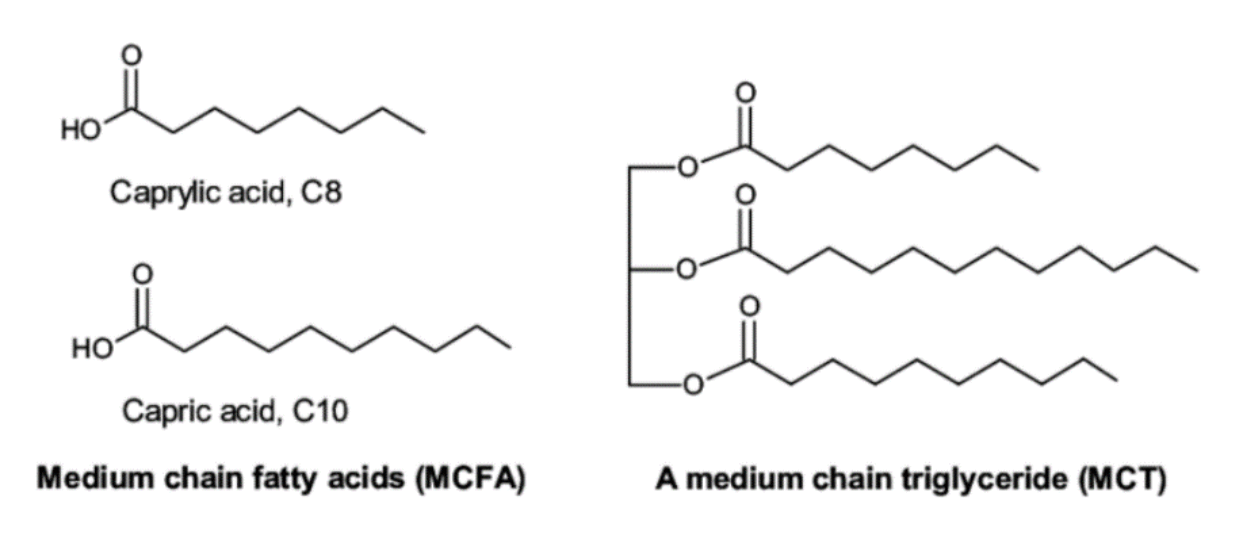24 Oct 2023
Cecilia Villaverde discusses a variety of studies behind these fats, as well as their effects on neurological activity in canine patients.

Image © freshidea / Adobe Stock

In healthy animals, glucose is the primary energy source used by the brain, which is required as a continuous supply due to lack of storage capabilities in this organ. The brain uses a large proportion of body glucose; for example, in humans, it consumes 20% (Mergenthaler et al, 2013).
In certain neurological conditions, brain glucose metabolism becomes impaired. This has been identified in epileptogenic brain regions in humans, rodents and dogs (Han et al, 2021), as well as in people affected by Alzheimer’s disease (Pan et al, 2018). Overall, cerebral glucose metabolism is reduced in healthy ageing humans and animals, and is significantly lower in people with Alzheimer’s disease (Pan et al, 2018).
Medium chain triglycerides (MCTs) are comprised of a glycerol backbone attached to three medium chain fatty acids (MCFA), which are saturated.
Medium chain length fatty acids contain between 6 and 12 carbon atoms, which differentiates them from either short chain or long chain fatty acids (Jadhav et al, 2022). These MCTs have been found to have effects on brain activity – especially caprylic and capric acid (Berk et al, 2019; Table 1).
| Table 1. Medium chain fatty acids | ||
|---|---|---|
| C6 | Hexanoic acid | Caproic acid |
| C8 | Octanoic acid | Caprylic acid |
| C10 | Decanoic acid | Capric acid |
| C12 | Dodecanoic acid | Lauric acid |
MCTs provide fewer calories compared to long chain triglycerides (LCT; Figure 1). The net energy value of MCTs has been calculated at 6.8 plus-minus 0.15 [CV1] kcal/g, which is less than that of LCTs in typical fats (9 kcal/g; Matulka et al, 2009).
However, the calories provided by MCT supplementation should be accounted for as part of the daily caloric intake in all patients – especially in patients where weight control is an issue.
Calories not coming from the main food can result in nutrient dilution, and the overall recommendation is to keep all unbalanced items below 10% of the daily calories (Freeman et al, 2011).
When MCTs are ingested, the MCFAs are initially released from the glycerol backbone by the enzyme lipase.
Due to their shorter chain length, MCFAs are believed to be mainly transported via the hepatic portal vein to the liver for immediate metabolism rather than via the lymphatic system, as opposed to longer, more hydrophobic fatty acids, but data is still lacking in this area.
Within the liver, they undergo a process of β-oxidation to form ketone bodies, a source of immediate energy (Matulka et al, 2009). The transport of MCFAs into the mitochondrial matrix for β-oxidation does not require the carnitine shuttle system that is necessary for long chain fatty acids and, therefore, MCFAs are metabolised at a quicker rate when compared with LCTs (Law et al, 2018).
Unlike other fatty acids, MCFAs are not primarily transported to the adipose tissue for storage (Jadhav et al, 2022).

MCTs can provide an alternative energy source to glucose in the brain, with both ketone bodies and MCFAs having the ability to cross the blood-brain-barrier (Molina 2020).
The addition of MCTs to the diet has been shown to increase mitochondrial function in dogs, increase metabolic synthesis of polyunsaturated fatty acids and their uptake, and inhibit excitatory neurotransmission in brain tissue (Molina et al, 2020; Chang et al, 2016; Berk et al, 2019). These are the suggested modes of action of the positive effects of MCT supplementation stated at a later point, although knowledge in this area is, as yet, incomplete. The effects may also vary depending on the different specific MCFAs used.
Studies have shown that dietary MCTs can reduce seizure frequency in some dogs with epilepsy (Law et al, 2015; Han et al, 2021) together with medical management. Additionally, behavioural changes, such as increased excitability, chasing behaviours and reduced trainability, have been seen in epileptic dogs, and these can also be improved with MCT supplementation (Packer et al, 2016), suggesting they may have applications in stress and behavioural management.
MCTs also have suggested uses in dogs affected by cognitive dysfunction syndrome (CDS). Research suggests that MCT-enriched diets can improve the clinical signs of CDS in senior dogs, not affected by concurrent epilepsy (Pan et al, 2018).
Compared to the general canine population, dogs with epilepsy develop cognitive impairments at an earlier age (four to six years), due to a quicker onset and reduced life expectancy (Berk et al, 2021; Packer et al, 2018).
MCT supplementation in epileptic dogs was shown to significantly improve spatial working memory, problem solving and owner-reported trainability (Berk et al, 2021). Dietary MCTs could, therefore, be used to support healthy brain function in older dogs, including those patients affected by epilepsy and CDS.
In summary, research has demonstrated the benefits of MCTs in improving neurological health in dogs, in particular those with epilepsy and those with CDS.
Therefore, MCT supplementation (via an enriched diet or a supplement) is a consideration for the adjunctive management of these conditions in practice.